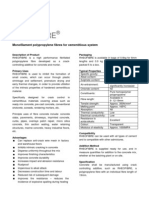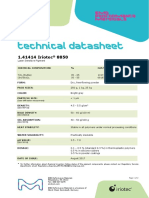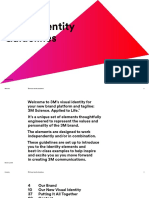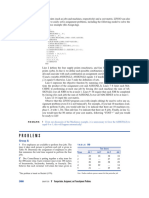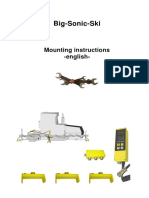Effect Pigments
Effect Pigments
Uploaded by
Gwen WalkerCopyright:
Available Formats
Effect Pigments
Effect Pigments
Uploaded by
Gwen WalkerOriginal Description:
Copyright
Available Formats
Share this document
Did you find this document useful?
Is this content inappropriate?
Copyright:
Available Formats
Effect Pigments
Effect Pigments
Uploaded by
Gwen WalkerCopyright:
Available Formats
Quelle/Publication: European Coatings Journal
Ausgabe/Issue: 09/2009
Seite/Page: 1
Getting the best effect pigment orientation
The selection of a suitable rheology additive is a shear thinning during application and the viscosity quickly
decisive factor in the optimization of effect pigment returns to the initial level after application. However,
orientation in waterborne effect pigment base coats. thixotropic rheology additives have limitations with respect
The additive should produce pseudoplastic flow to the effect pigment orientation, because the viscosity of
characteristics, the required minimum viscosity and the paint initially remains at the lower level after shearing,
a sufficiently high degree of elasticity. Oscillatory with the result that the pigments can easily lose their initial
evaluation of the viscoelastic behaviour is an effective orientation. Increasing the concentration of the additive can
test method for effect pigment orientation assessment. speed up the rise in viscosity and thus compensate for this
undesirable effect.
Influence of rheology in waterborne paint systems The viscosity of the formulation (minimum viscosity) must
Sylvia Bühne be tailored to the application properties in order to obtain
Axel Woocker* a homogeneous spray pattern. If the viscosity is too low,
Anne Linzmaier sag resistance is limited and may lead to edge crawling and
Rheology additives are indispensable for good effect cloudiness.
pigment orientation in waterborne paint systems. They In addition to these parameters, the viscoelastic properties
help to optimize the viscoelastic properties of the paint. are also important. The elastic components, in particular,
Rheology-modifying wax additives give particularly good are crucial for good effect-pigment orientation. They must
results. be at a higher level than the viscous components after spray
In many sectors of the paint industry, there is a clear application. The pigment particles are then fixed in a weak
trend toward environmentally friendly, waterborne coatings, gel structure and cannot change their orientation during
particularly for the automotive industry. Paint developers drying.
are faced with new challenges due to the different physical In contrast, it is more difficult to achieve good orientation
and application engineering properties of waterborne in products with predominantly viscous properties. Although
compared to solventborne formulations. a high application viscosity can be obtained by controlling
Metallic effects are obtained by the use of special-effect the dosage, thus reducing the mobility of the pigments in
pigments. An optimum appearance requires a uniform the wet film, compensation of the missing elastic component
distribution of pigments within the coating, so that they is not possible and the result is a compromise between
deflocculate and orient themselves parallel to the substrate orientation, leveling properties and edge crawling (Figure
(Figure 1). The metallic effect is the variation of perceived 3).
colour due to the differing degree of light reflection at various Viscoelastic substances are characterized by a combination
viewing angles (flip-flop) (Figure 2) [1]. of elastic and viscous properties. However, the term itself
does not indicate which of the two properties dominates.
Additive selection crucial Elastic substances store deformation energy under a shear
Effect pigments can have good orientation in solvent-borne load and release it when unloaded (a spring is 100 %
base coats even without special rheology additives. The film elastic), whereas viscous substances lose this energy as
dries so rapidly that the effect pigments are quickly fixed in a frictional heat during the flow process (water is 100 %
horizontal orientation. Rheology additives are primarily used viscous) [2].
to improve the stability in circulation systems by preventing The viscoelastic properties are determined by carrying out
settling of the heavier effect pigments. oscillatory measurements with a rheometer. The measured
In contrast, in waterborne base coats, rheology additives rheological parameters are G’ (storage modulus = elastic
have a considerable impact on the appearance. Selecting components) and G’’ (loss modulus = viscous components),
the right additive can be a decisive factor to achieve from which clear conclusions can be drawn with respect to
optimum effect-pigment orientation. This is because water an optimum effect pigment orientation (Figure 4).
evaporates much more slowly than solvents, thus extending
the drying time. The applied paint is significantly "wetter" Pseudoplastic and elastic properties in one
when it arrives on the substrate; therefore the effect Although additives such as clays and acrylate thickeners
pigments remain mobile for longer and may lose their initial are generally suitable for adjusting the viscosity (minimum
orientation. viscosity) and for increasing the required elasticity, they
It is crucial for the selection of suitable rheology additives are not easy to handle. Clays are difficult to disperse and
to know which properties have a positive effect on frequently cause seeding, even if incorporated as a semi-
the orientation. The rheological requirements include finished product. Acrylate thickeners often result in greying
resistance to settling of the pigments during storage. of the base coat even though they are already pre-diluted
Furthermore, an appropriate application viscosity and a and pre-neutralized to facilitate handling.
rapid increase in the viscosity after application are needed PUR thickeners are usually easy to handle; however
to obtain a uniform spray pattern. they show no appreciable elastic properties. A further
A pseudoplastic (thixotropic) paint fulfills these disadvantage is their variable efficiency due to their
requirements, because the material undergoes significant associative behaviour with the binder. The effect of aqueous
Vincentz Network +++ Plathnerstr. 4c +++ D-30175 Hannover +++ Tel.:+49(511)9910-000
Quelle/Publication: European Coatings Journal
Ausgabe/Issue: 09/2009
Seite/Page: 2
polyamides, which are not widely used, is also very system- As expected, the elastic as well as the viscous components
dependent and they are as challenging to handle as the increased with the level of RM wax additive. The elastic
clays. An entirely new class of additives for waterborne components in this formulation dominated over the viscous
systems is now available rheology-modifying wax additives components above a concentration of 5 %. Measurements
(RM wax additives). They have been used successfully for in the third interval showed that the speed of structural
many years in solventborne systems and they have now recovery increased with the amount of additive.
been adapted for use in waterborne materials. An RM wax For an application performance evaluation, the base coats
additive has pseudoplastic flow behaviour and significant were applied with an automatic sprayer under identical
elasticity. The product is easy to use and shows a good conditions and then finished with a clear coat. (The sample
compatibility. In contrast, conventional wax additives exhibit with 4 % RM wax additive was not included in the application
only very limited rheological effects in waterborne systems performance tests, because its elasticity and viscosity were
and thus have to be used in combination with rheology too low.) The application result was then measured optically
additives (Table 1). using a Byk-mac, an instrument that measures the total
Comprehensive tests of various rheology additives in a colour impression of effect paints, changes of colour and
metallic base coat formulation, with detailed studies of the the sparkle effect. Flip flop, homogeneity and intensity of
viscoelasticity, have demonstrated the influence of rheology the metallic effect were also evaluated. In addition, edge
and, in particular, the elastic components, on the effect crawling along with the overall homogeneity of the paint film
pigment orientation (Table 1). was assessed visually.
A good illustration of this is a comparison of a basecoat The rheological results correlated well with the application
containing the RM wax additive with one with a PUR results. The orientation improved as the elasticity increased.
thickener, because these two types of additive differ The sample with 7 % RM wax additive gave the best result.
the most with respect to viscoelastic behaviour. The Even higher amounts of additive increased the elasticity,
viscoelasticity of the two differing base coats and a ‘blank’ however, they also increased the viscosity so that spray
sample without additive was evaluated using oscillation application was no longer practicable.
tests. The samples were subjected to a given frequency The results depended on the solids content of the
(1 Hz) at continuously increasing amplitude (deformation formulation and on the type of binder. Thus, the optimum
0.1-100 %) (Figure 5). amount of additive is always system-dependent (Table 2).
Irrespective of the degree of deformation, viscous behaviour
dominated in the blank sample (G’’ >> G’). The elastic Optimization by combining additives
components are negligible and are thus not included in the The results clearly demonstrate that, based purely on flip-
diagram. The base coat containing PUR thickener showed flop values, the largest light / dark difference occurs in
very similar behaviour, however, the viscous components a sample containing 5 % RM wax additive; however, the
were significantly higher. The elastic components were also distribution of effect pigments and the coating film thickness
well below those of the viscous components. are homogeneous for the sample containing 7 % of the
In contrast, the base coat with the RM wax additive behaved additive.
completely differently. The elastic components clearly Therefore, the next step was to check whether the
dominated. This behaviour persisted over a wide range, use of a suitable combination of RM wax additive and
even as the level of deformation increased. Structural a predominantly viscous additive (PUR thickener) can
degradation with a transition to more viscous behaviour only optimize the effect pigment orientation compared to a
occurred at high levels of deformation (intersection of G’ sample containing 7 % RM wax additive only. The
and G’’). This essential difference in the measured results is combination tested was 5 % RM wax and 0.2 % PUR
reflected in the application performance; the aluminum flake thickener. The amount of PUR thickener was selected so
orientation, homogeneity and edge crawling of the paint film that both base coats had the same Brookfield viscosity (DVI,
were all significantly improved. spindle 4, 50 rpm, 550 mPas).
The evaluation was carried out with the three-interval
Influence of elasticity measurement (ORO) (Figure 7). In the first interval, the
The influence of elasticity on the effect-pigment orientation combination with the PUR thickener increased the viscosity
was studied with samples containing differing amounts of and thereby the values of G’ and G’’; the elastic components
RM wax additive. The solids proportion (SP) of the samples (G’) dominated. In the third interval, directly after shearing,
was kept constant to avoid a further variable. the viscous components initially dominated (G’’ > G’).
In practice, the base coat undergoes strong shearing Subsequently, the two curves intersected as the structure
during application. The elastic components then recover recovered and the elastic components quickly became most
at differing speeds, depending on the amount of additive. important (G’ > G’’). It is worth noting that the PUR
This was simulated by using a step function with three thickener did not affect the speed of structural recovery.
intervals giving oscillation-rotation-oscillation (ORO). In the Although the elastic components predominated
first interval, the unsheared sample was measured under immediately after shearing in the formulation with 7 %
oscillation to determine the initial level of viscoelasticity RM wax additive, at 5 % RM wax additive, the viscous
(G’ and G’’). In the second interval, spray application components dominated for a short time. This also favoured
was simulated by a rotation test in which the samples an ideal effect-pigment orientation: the effect pigments can
were subjected to brief but strong shearing to destroy the orientate even better directly after application if they are not
existing structures. In the third interval, another oscillatory immediately fixed in the elastic gel structure of the base
measurement was carried out to evaluate the level of coat. The decisive factor is that this structural recovery with
elasticity and the speed of structural recovery (Figure 6). a changeover to predominantly elastic components does
Vincentz Network +++ Plathnerstr. 4c +++ D-30175 Hannover +++ Tel.:+49(511)9910-000
Quelle/Publication: European Coatings Journal
Ausgabe/Issue: 09/2009
Seite/Page: 3
not last too long; otherwise the effect pigments can lose their
initial orientation.
The additive combination gave the best overall application
result. The flip-flop effect is significantly better than the
formulation with 7 % RM wax additive and there is no
reduction in the homogeneity and intensity of the metallic
effect (Table 3).
References:
[1] Wißling, P., Metalleffekt-Pigmente, Vincentz Network,
2005. [2] Mezger, T., Das Rheologie-Handbuch, Vincentz
Network, 2006.
Results at a glance
Suitable rheology additives are necessary for a good
effect pigment orientation in waterborne base coats.
Decisive factors for a good result are pseudoplastic
flow behaviour, a suitable level of viscosity (minimum
viscosity) and predominantly elastic components after
spray application. A new class of waterborne rheology-
modifying wax additives provides a very good effect pigment
orientation. Combinations of additives can be optimized
even further to achieve an ideal ratio between the elastic
and viscous components.
Vincentz Network +++ Plathnerstr. 4c +++ D-30175 Hannover +++ Tel.:+49(511)9910-000
Quelle/Publication: European Coatings Journal
Ausgabe/Issue: 09/2009
Seite/Page: 4
Figure 1: Good (left) and poor (right) orientation of aluminum flakes in metal-
effect paints (optical microscopy)
Vincentz Network +++ Plathnerstr. 4c +++ D-30175 Hannover +++ Tel.:+49(511)9910-000
Quelle/Publication: European Coatings Journal
Ausgabe/Issue: 09/2009
Seite/Page: 5
Figure 2: Ideal flip-flop and high
brilliance are obtained when the flakes
are oriented parallel to the surface
in a uniform distribution and without
agglomeration
Vincentz Network +++ Plathnerstr. 4c +++ D-30175 Hannover +++ Tel.:+49(511)9910-000
Quelle/Publication: European Coatings Journal
Ausgabe/Issue: 09/2009
Seite/Page: 6
Figure 3: Viscosity and viscoelasticity
of the paint formulation have a
significant impact on the finished
appearance
Vincentz Network +++ Plathnerstr. 4c +++ D-30175 Hannover +++ Tel.:+49(511)9910-000
Quelle/Publication: European Coatings Journal
Ausgabe/Issue: 09/2009
Seite/Page: 7
Figure 4: Liquids with differing
viscoelastic behaviour
Vincentz Network +++ Plathnerstr. 4c +++ D-30175 Hannover +++ Tel.:+49(511)9910-000
Quelle/Publication: European Coatings Journal
Ausgabe/Issue: 09/2009
Seite/Page: 8
Figure 5: Oscillatory measurements
provide information on the viscous
(G’’) and elastic components (G’) of
the paint formulations containing an
RM wax or a PUR thickener as the
additive
Vincentz Network +++ Plathnerstr. 4c +++ D-30175 Hannover +++ Tel.:+49(511)9910-000
Quelle/Publication: European Coatings Journal
Ausgabe/Issue: 09/2009
Seite/Page: 9
Figure 6: Effect of the RM wax additive
concentration on the viscoelastic
behaviour
Vincentz Network +++ Plathnerstr. 4c +++ D-30175 Hannover +++ Tel.:+49(511)9910-000
Quelle/Publication: European Coatings Journal
Ausgabe/Issue: 09/2009
Seite/Page: 10
Figure 7: Viscoelastic behaviour: base
coats containing 5 % and 7 % RM wax
additive compared to a formulation
containing a combination of RM wax
additive and PUR thickener
Vincentz Network +++ Plathnerstr. 4c +++ D-30175 Hannover +++ Tel.:+49(511)9910-000
You might also like
- The Industrial Coatings MarketDocument5 pagesThe Industrial Coatings MarketjagrititanuNo ratings yet
- 41 Processing Note f1 Molding of Ptfe Granular PowdersDocument36 pages41 Processing Note f1 Molding of Ptfe Granular PowdersMahmoud Nael0% (1)
- Next Generation HEUR Technology CoatingsTech March2014Document9 pagesNext Generation HEUR Technology CoatingsTech March2014Arturo Antonio Matencio ArroyoNo ratings yet
- Acrysol rm-8w 3Document4 pagesAcrysol rm-8w 3Forever0% (1)
- Aqueous Coatings Guide: Chuck Malspeis Coatings Product Development ManagerDocument16 pagesAqueous Coatings Guide: Chuck Malspeis Coatings Product Development ManagerMohamed NouzerNo ratings yet
- Chlorinated-Polyethylene-Rubber 6 PDFDocument4 pagesChlorinated-Polyethylene-Rubber 6 PDFAsit RayNo ratings yet
- 3M NOVEC FC-4430 Fluorosurfactant Product Information (98-0212-4160-3) Dec 2009Document4 pages3M NOVEC FC-4430 Fluorosurfactant Product Information (98-0212-4160-3) Dec 2009Miguel Vallejos MelendresNo ratings yet
- Rheofibre - BasfDocument2 pagesRheofibre - BasftheshadowknightNo ratings yet
- EfflorescenceDocument2 pagesEfflorescenceMihaiu AdrianNo ratings yet
- Aqueous Coating GuideDocument16 pagesAqueous Coating GuideKC Kiew100% (1)
- 3m FluosufactantDocument4 pages3m Fluosufactantuzzy2No ratings yet
- RP4036 PDFDocument5 pagesRP4036 PDFA MahmoodNo ratings yet
- Col.9 7671Document17 pagesCol.9 7671Thanh VuNo ratings yet
- Rust ConverterDocument2 pagesRust ConvertergabictbNo ratings yet
- Paint SpecDocument9 pagesPaint SpectalabizNo ratings yet
- Catalogo Aditivos AfconaDocument44 pagesCatalogo Aditivos AfconaMaleja HerediaNo ratings yet
- Carboline Techy GuideDocument31 pagesCarboline Techy GuideAnnmNo ratings yet
- Iriotec - 8850 - EMD - TDS (For US and Canada) PDFDocument2 pagesIriotec - 8850 - EMD - TDS (For US and Canada) PDFxy2zjgNo ratings yet
- Opti FloDocument11 pagesOpti FloAna QuintanaNo ratings yet
- Clariant Additives For PaintsDocument11 pagesClariant Additives For PaintsAbsalon Fernando RiascosNo ratings yet
- PE Replacement Barrier CoatingsDocument3 pagesPE Replacement Barrier CoatingsAnuj100% (1)
- S2300 PaintDocument40 pagesS2300 PaintArun KastwarNo ratings yet
- (N) Guide To Selecting Surface-Treated Pigments and Powders 5 PDFDocument16 pages(N) Guide To Selecting Surface-Treated Pigments and Powders 5 PDFEllen GurNo ratings yet
- Pergut S 20 enDocument3 pagesPergut S 20 enCesar MartinezNo ratings yet
- GA-013 Functional Coatings BrochureDocument6 pagesGA-013 Functional Coatings Brochuregopinath87No ratings yet
- Acronal 7079 PI EDADocument3 pagesAcronal 7079 PI EDAGokul Basker100% (2)
- Jan 2010 Oxylink Updated Sales Presentation PDFDocument44 pagesJan 2010 Oxylink Updated Sales Presentation PDFdainguyenlamNo ratings yet
- Norsolene M SeriesDocument5 pagesNorsolene M SeriesVictor LopezNo ratings yet
- J P G T: HapterDocument28 pagesJ P G T: HapterKali AbdennourNo ratings yet
- BNP Pci 201004Document109 pagesBNP Pci 201004leethinh79No ratings yet
- Presentation - Fire Safety - DSMDocument10 pagesPresentation - Fire Safety - DSMDr AmirNo ratings yet
- BYK L-DI 1 EN OnlineDocument20 pagesBYK L-DI 1 EN OnlineHelene Di marcantonioNo ratings yet
- Primal ICC 3Document2 pagesPrimal ICC 3hongducxxxNo ratings yet
- Pergut EDocument17 pagesPergut ECesar MartinezNo ratings yet
- Kansai Paint Write Up 2013Document30 pagesKansai Paint Write Up 2013Ali ShafiqueNo ratings yet
- Measuring Nacl, Salt, and Soluble Contaminants With Bresle Patches-Part 1Document8 pagesMeasuring Nacl, Salt, and Soluble Contaminants With Bresle Patches-Part 1Hami Keserci100% (1)
- TDS - Panax Yellow 3RDocument1 pageTDS - Panax Yellow 3RRio AndriyantoNo ratings yet
- Brand AQAGloss-Brochure - Product Overview Polymer Dispersions Architectural Coatings-EnglishDocument6 pagesBrand AQAGloss-Brochure - Product Overview Polymer Dispersions Architectural Coatings-Englishfrox123No ratings yet
- NEI Anticorrosion Paints & Coatings BrochureDocument3 pagesNEI Anticorrosion Paints & Coatings Brochurefallen010% (1)
- 3 Binders For Eco FormulationsDocument80 pages3 Binders For Eco FormulationsCarolinaMaria Consonni100% (1)
- AquaSolve As HandbookDocument16 pagesAquaSolve As Handbookmaneshdixit4312No ratings yet
- Barriers of Protections BrochureDocument8 pagesBarriers of Protections BrochureJaime Rousseau TNo ratings yet
- Evonik-Ancamide 221-X70 - EUDocument5 pagesEvonik-Ancamide 221-X70 - EUMOHAMED100% (1)
- 2015 Sustainable Dispersing Agents For Label Free Pigment PreparationsDocument8 pages2015 Sustainable Dispersing Agents For Label Free Pigment PreparationsNiko KraljNo ratings yet
- Epoxy CureDocument5 pagesEpoxy CureElias Kapa100% (1)
- ChemicalDocument5 pagesChemicalisaac2408No ratings yet
- Coatings Knowledge, Basic Paint Technology - HMG Paints LimitedDocument3 pagesCoatings Knowledge, Basic Paint Technology - HMG Paints LimitedShyam Yadav0% (1)
- Paints and Coatings Failures: A Guide Book On Causes and RemediesDocument8 pagesPaints and Coatings Failures: A Guide Book On Causes and RemediesgenrryNo ratings yet
- KMS183 PDFDocument6 pagesKMS183 PDFSabyasachi Naik (Zico)100% (1)
- Ydf-170,175 TDS 4Document2 pagesYdf-170,175 TDS 4uzzy2No ratings yet
- Offshore Oil & Gas: System GuideDocument8 pagesOffshore Oil & Gas: System GuideHasan AkdagNo ratings yet
- Jotamastic 87: Technical Data SheetDocument5 pagesJotamastic 87: Technical Data SheetMuhammad Fitransyah Syamsuar PutraNo ratings yet
- 0901 B 80380046 F 8 FDocument8 pages0901 B 80380046 F 8 F8612106535No ratings yet
- Pigment Dispersion: Theodore G. VernardakisDocument19 pagesPigment Dispersion: Theodore G. VernardakisSyafri GtNo ratings yet
- Properties of EB Top-Coated Metallized Films Prepared in VacuumDocument8 pagesProperties of EB Top-Coated Metallized Films Prepared in VacuumLý Phương NamNo ratings yet
- Industrial Inorganic PigmentsFrom EverandIndustrial Inorganic PigmentsGunter BuxbaumRating: 5 out of 5 stars5/5 (1)
- Biopolymers: New Materials for Sustainable Films and CoatingsFrom EverandBiopolymers: New Materials for Sustainable Films and CoatingsDavid PlackettNo ratings yet
- Leveling Sagging Tester PDFDocument1 pageLeveling Sagging Tester PDFGwen WalkerNo ratings yet
- Prof. P. R. Vavia ResumeDocument50 pagesProf. P. R. Vavia ResumeGwen WalkerNo ratings yet
- Easily Dispersible PigmentsDocument44 pagesEasily Dispersible PigmentsGwen WalkerNo ratings yet
- Trifecta Visual GuidelinesDocument84 pagesTrifecta Visual GuidelinesGwen WalkerNo ratings yet
- India's Paint Industry Expects Strong FutureDocument3 pagesIndia's Paint Industry Expects Strong FutureGwen Walker100% (1)
- Pencil HardnessDocument1 pagePencil HardnessGwen WalkerNo ratings yet
- Available Online Through: International Journal of Mathematical Archive-4 (12), 2013Document4 pagesAvailable Online Through: International Journal of Mathematical Archive-4 (12), 2013Gwen WalkerNo ratings yet
- 5 JfrtArticle 1.Pdf0Document9 pages5 JfrtArticle 1.Pdf0Gwen WalkerNo ratings yet
- Intensification of Synthesis of Crystalline Zinc Phosphate (Zn3 (PO4) 2) Nanopowder: Advantage of Sonochemical Method Over Conventional MethodDocument6 pagesIntensification of Synthesis of Crystalline Zinc Phosphate (Zn3 (PO4) 2) Nanopowder: Advantage of Sonochemical Method Over Conventional MethodGwen WalkerNo ratings yet
- Historylasers PDFDocument8 pagesHistorylasers PDFGwen WalkerNo ratings yet
- NSC CalculatorDocument2 pagesNSC CalculatorAshokNo ratings yet
- Blade Gen ReportDocument80 pagesBlade Gen ReportSunil NairNo ratings yet
- Acan Fg-8100 ManualDocument70 pagesAcan Fg-8100 Manualblimblum75% (4)
- Case StudyDocument7 pagesCase StudyRohaib KhanNo ratings yet
- Learn Laravel in 1 Week: Devan SingaramDocument35 pagesLearn Laravel in 1 Week: Devan SingaramLeonard Rumisov100% (1)
- TD Mock ExamDocument7 pagesTD Mock ExamTriplejayartNo ratings yet
- A Model of Traffic Light System by The Application of PLC - Zarizal Eddy - TE228.Z37 2008 PDFDocument28 pagesA Model of Traffic Light System by The Application of PLC - Zarizal Eddy - TE228.Z37 2008 PDFMona AliNo ratings yet
- X PGNDP0464 03 ECI SPC 020 Control Valve Specification RevADocument7 pagesX PGNDP0464 03 ECI SPC 020 Control Valve Specification RevAgrantNo ratings yet
- Kolej Matrikulasi Pulau Pinang: Unit MatematikDocument28 pagesKolej Matrikulasi Pulau Pinang: Unit MatematikComplicated Sangat SangatNo ratings yet
- RAINS Radiographic Principles 2019Document32 pagesRAINS Radiographic Principles 2019artspiceNo ratings yet
- The Development of Multi-AxisDocument148 pagesThe Development of Multi-AxissyedabdulhannanNo ratings yet
- Fluids and Lubricants Specifications: Diesel Engine-Generator Sets With Series 2000 and 4000 MTU EnginesDocument135 pagesFluids and Lubricants Specifications: Diesel Engine-Generator Sets With Series 2000 and 4000 MTU EnginesPhat Chau ThuanNo ratings yet
- Books 3337 0-Trang-2Document3 pagesBooks 3337 0-Trang-2blackpink199567No ratings yet
- MXQ ADocument198 pagesMXQ AHarry laksanaNo ratings yet
- 10-02-02101 Installation Manual Big-Ski Modular MOBA-Version enDocument23 pages10-02-02101 Installation Manual Big-Ski Modular MOBA-Version enalex72No ratings yet
- TS 4317 XDocument12 pagesTS 4317 Xwaldo545100% (1)
- OTC-25676-MS Implementing Constructability in Brownfield Projects: A Case StudyDocument13 pagesOTC-25676-MS Implementing Constructability in Brownfield Projects: A Case StudyFrancisco DondaNo ratings yet
- Differential Pulse Voltammetric Determination of Paracetamol at Nanogold Modified Indium Tin Oxide ElectrodeDocument5 pagesDifferential Pulse Voltammetric Determination of Paracetamol at Nanogold Modified Indium Tin Oxide ElectrodeYoselin GomezNo ratings yet
- Production Logging: Quartz Pressure, Single Sensor Tool QPS019: 1Document34 pagesProduction Logging: Quartz Pressure, Single Sensor Tool QPS019: 1Juan DavidNo ratings yet
- DWTU FinalDocument15 pagesDWTU FinalsartNo ratings yet
- Discover 125 - TRG Note-IbDocument49 pagesDiscover 125 - TRG Note-Ibviaerea100% (1)
- Siva Final Updated (2) (1 PDFDocument57 pagesSiva Final Updated (2) (1 PDFSanthoshNo ratings yet
- Ghazipur Class 12 Summer Vacation HomeworkDocument5 pagesGhazipur Class 12 Summer Vacation HomeworkTitan'S HereNo ratings yet
- Dilucion TeoriaDocument9 pagesDilucion TeoriaJorge Luis CJviba Vizarres BarrenacheaNo ratings yet
- Cube Difference Labeling of Theta GraphsDocument4 pagesCube Difference Labeling of Theta GraphsAnonymous izrFWiQ100% (1)
- All Out Support Basketball FY19Document102 pagesAll Out Support Basketball FY19Tad Aquinas PorralNo ratings yet
- Theory of ComputationDocument145 pagesTheory of ComputationM KISHORE,CSE(19-23) Vel Tech, ChennaiNo ratings yet
- Doc-20240512-Wa0003 240513 125207Document4 pagesDoc-20240512-Wa0003 240513 125207mohammed galalNo ratings yet







